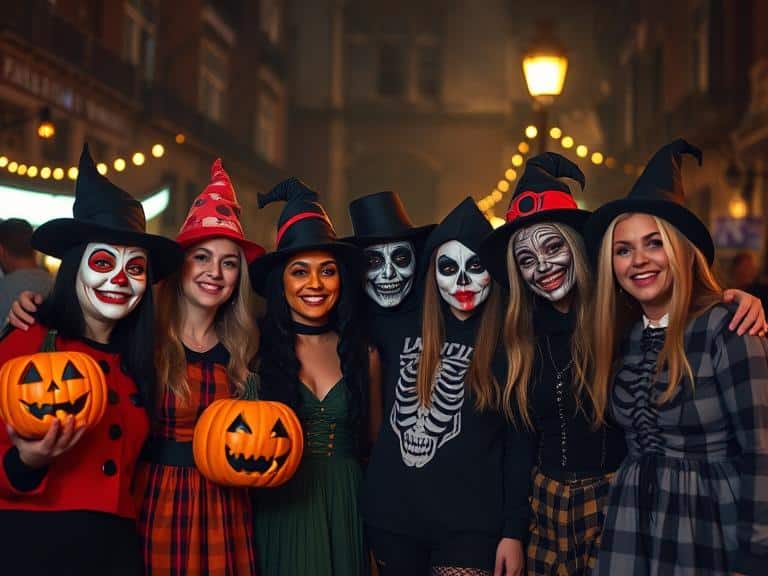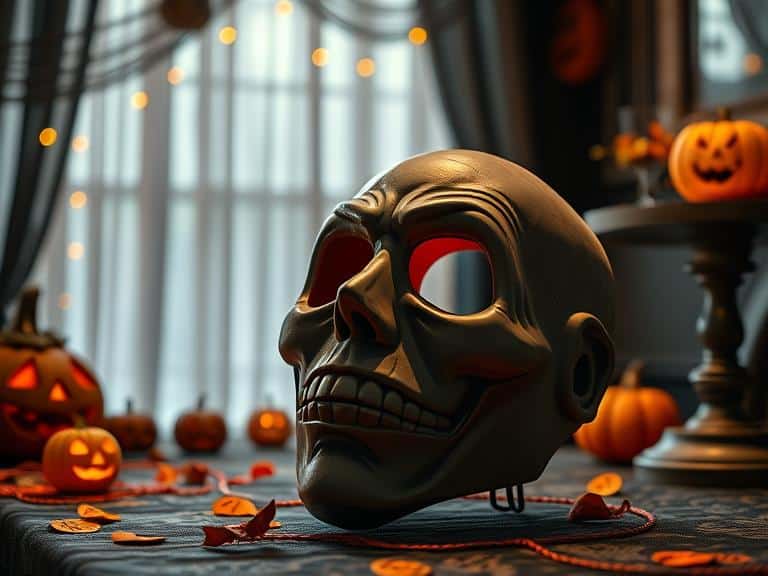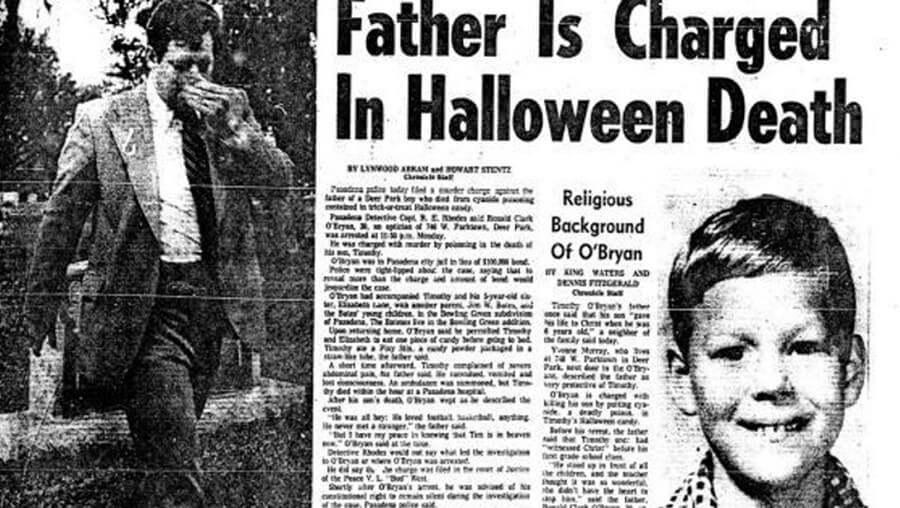Halloween night has borne witness to some of modern crime history’s most chilling and inexplicable homicides, cases where festive celebration masks sinister intent, blurring the boundary between seasonal mischief and calculated malice.
The cultural fascination with Halloween naturally lends itself to macabre storytelling. After all, this is the one night of the year when, as crime researcher James T. Bartlett notes, “anyone can wear an outlandish mask… carry a huge ax, or a machete, or wear gloves with knives for fingers, and no one will bat an eyelid.” This unique social environment, where disguise is normalized and the boundaries between playful fear and genuine threat are temporarily relaxed, creates circumstances unlike any other holiday.
Nevertheless, it’s crucial to understand that while Halloween killings capture public imagination and generate sensational headlines, they represent a complex intersection of crime, opportunity, and cultural mythology.
The Psychology of Halloween Violence
Halloween inherently creates a unique psychological landscape that can influence human behavior in subtle yet significant ways. The holiday’s emphasis on identity concealment, boundary transgression, and fear as entertainment establishes conditions markedly different from ordinary social environments. This distinctive atmosphere, consequently, contributes to measurable increases in certain types of criminal activity.
Criminologists have long observed what they term “the mask effect” a form of psychological disinhibition that occurs when individuals operate from behind concealed identities. As Professor James Alan Fox of Northeastern University explains, “Halloween provides a certain level of anonymity that can reduce accountability in some individuals.”

This anonymity doesn’t necessarily create violent tendencies where none existed, but rather lowers thresholds for those already predisposed to antisocial behavior. Furthermore, research indicates that costume choices themselves can influence behavior, with individuals often acting in alignment with their adopted personas, a phenomenon psychologists call “enclothed cognition.“
Beyond psychological factors, Halloween presents a perfect storm of opportunity elements that criminals can exploit. After dark, neighborhoods experience unusually high pedestrian traffic, with residents more willing to open doors to strangers than on any other night. Additionally, Halloween festivities frequently involve alcohol consumption among adults, which notoriously impairs judgment and heightens emotional reactivity. “The city of Los Angeles experiences approximately 26% more crimes on Halloween compared to an average day,” notes LAPD data, highlighting how these opportunity factors translate into statistical realities.
Social dynamics further complicate the picture. Halloween celebrations often bring together unfamiliar individuals in crowded, stimulating environments. These conditions can spark territorial disputes, jealousy-driven confrontations, or misjudged interactions, especially when normal social cues are obscured by costumes and altered states of consciousness. Dr. Lisa Feldman Barrett, a neuroscientist specializing in emotion, suggests that “in contexts where normal social scripts are temporarily suspended, people become more reactive to perceived slights or threats.“

Nevertheless, while these psychological and situational factors help explain the statistical increases in Halloween violence, most criminal justice experts emphasize that they don’t predetermine outcomes.
“The vast majority of Halloween participants navigate the night without incident, despite the psychological pressure points the holiday creates.” – Criminologist Dr. Scott Bonn
Understanding these dynamics doesn’t excuse criminal behavior but rather helps illuminate why October 31st consistently registers higher-than-average incident reports across multiple crime categories and why certain Halloween murders take on particularly unusual characteristics.
Notable Halloween Killings: Case Studies
Throughout the years, Halloween night has set the stage for some truly disturbing homicides. These cases not only highlight the unique circumstances that make October 31st different from other days but also demonstrate how real-life horrors can unfold while most people are engaged in festive celebrations.

The Los Angeles Halloween Killings
Los Angeles has a particularly dark history of Halloween homicides. In 1957, beauty salon owner Peter Fabiano answered his door on Halloween night to what he thought was a late trick-or-treater. As he reached for his candy bowl, he commented, “It’s a little late for this, isn’t it?” Seconds later, a fatal shot rang out. The “trick-or-treater,” dressed in blue jeans, a khaki jacket, red gloves, and a mask had fired directly into his chest.
For months, police struggled to solve what they called a “gang land-style” shooting. The breakthrough came in March 1958 when investigators arrested an unexpected pair: Goldyne Pizer, a 43-year-old medical clerk, and Joan Rabel, a 40-year-old photographer. The investigation revealed that Rabel, a former employee at Fabiano’s salon, had developed what newspapers described as an “abnormal” relationship with Fabiano’s wife Betty during marital difficulties. When Peter insisted Betty end this relationship as a condition of their reconciliation, Rabel became enraged.
Over several months, Rabel manipulated Pizer, who later claimed she had been “dominated” by Rabel’s influence, convincing her that Fabiano was “a vile, evil man.” Together, they planned the murder, with Rabel taking Pizer to the salon multiple times so she could recognize Peter. Halloween provided the perfect cover, a night when a masked stranger at the door would raise no immediate alarm. After the shooting, Rabel coldly told Pizer: “Forget you ever knew me.“

After receiving sentences of five years to life in prison, both women were eventually released. Pizer returned to Los Angeles where she lived until her death in 1998, while Rabel’s post-prison life remains largely undocumented, though she is believed to have been released around the same time as her accomplice.
Deadly Halloween Shootings
Another shocking Los Angeles case occurred at a Van Nuys Halloween party in 1969. Kenneth A. Lindstrand, a 32-year-old directory publisher, arrived after 1 AM and danced with several female guests. Shortly after, he was chased back into the party by another male guest who opened fire. Strikingly, nearly 100 witnesses saw the shooting, but many initially thought it was part of the Halloween festivities. One woman dressed in a hula skirt even danced over Lindstrand’s body saying “This will wake him up!” until she noticed blood and shouted “This is no gag, he’s hurt!“
Jack Gentry Stearns, 35, eventually received a life sentence for the murder. His motive? Jealousy over Lindstrand dancing with his 22-year-old wife, Maria.
In 1974, Chinatown residents Mr. and Mrs. Low became victims of another Halloween attack. When 71-year-old Mrs. Low answered her door to apparent trick-or-treaters, one wearing a Wolf Man mask, another in a Frankenstein costume, they forced their way in at gunpoint. When her nearly-blind 81-year-old husband Pok Suey Low emerged from the bedroom, one of the intruders shot him in the chest.
The killers fled, leaving behind their masks, complete with fingerprints, and a bag of candy they had collected earlier while genuinely trick-or-treating. Months later, two 15-year-olds and 20-year-old Stephen Wai Chung Ho were arrested following another violent crime, and one teenager confessed to Low’s murder.
Halloween Slayings: Ronald Clark O’Bryan
Perhaps no Halloween murder has had more cultural impact than the 1974 case of Ronald Clark O’Bryan, known as “The Man Who Killed Halloween” or “The Candy Man.” This Texas father poisoned Pixy Stix with potassium cyanide and distributed them to five children on Halloween night, including his own 8-year-old son Timothy.

O’Bryan’s plan was sinister yet calculated: he would blame the poisoning on a mysterious neighbor, collect on the life insurance policy he had recently taken out on Timothy, and use the money to address his significant debt. After trick-or-treating, O’Bryan specifically encouraged Timothy to eat the poisoned candy. Within an hour, the boy was hospitalized and pronounced dead.
Due to fast-acting detectives who noticed the distinctive smell of cyanide, the other four poisoned Pixy Stix were confiscated before more children could become victims. Each contained enough poison to kill two people. The investigation quickly focused on O’Bryan, whose story contained numerous inconsistencies.
Convicted of capital murder, O’Bryan was executed by lethal injection on March 31, 1984. During his execution, a crowd of 300 people outside the prison chanted “Trick or treat!” and threw candy at a small group of anti-death penalty protesters.
Beyond the immediate tragedy, this case dramatically transformed Halloween in America, instilling widespread fear about candy tampering and creating safety practices that persist fifty years later. Despite the fact that O’Bryan remains the only confirmed case of deliberate Halloween candy poisoning by a stranger, his actions fundamentally changed how parents approach trick-or-treating.
The Toolbox Killers’ Final Victim
On Halloween night 1979, 16-year-old Shirley Lynette Ledford was hitchhiking home from a Halloween party when Lawrence Bittaker and Roy Norris – known as “The Toolbox Killers” – offered her a ride in their van. Ledford became the sadistic duo’s fifth and final victim, subjected to torture before being strangled. Her body was then callously dumped on a random front lawn.
The killers, who derived their nickname from their preference for torturing victims with common tools, were apprehended a month later. The Halloween timing of their final murder wasn’t coincidental. The holiday provided both increased opportunity, where more young people were out at night, and additional cover for suspicious activity.

Through these case studies, a disturbing pattern emerges. Halloween’s unique social environment, with its acceptance of disguise, strangers at the door, and blurred lines between frightening entertainment and genuine threat, creates conditions that certain killers have exploited to devastating effect.
Halloween Terror: Crime Trends
Behind the shocking individual cases, broader statistical patterns reveal that Halloween consistently ranks among the more dangerous nights of the year. Though these numbers don’t suggest everyone is at high risk, they do paint a picture of measurably increased danger compared to ordinary days.
According to data analyzed by Travelers Insurance, property-crime claims spike roughly 17% on Halloween compared to the daily average. More concerning, however, are the violent crime statistics. Northeastern University criminologist James Alan Fox notes that “the evening violent crime count on October 31 is about 50% higher than on any other date.” This isn’t merely academic speculation. Law enforcement agencies across the country confirm these trends through their own data collection.
The Los Angeles Police Department reports that crime rates on Halloween are approximately 26% higher than on typical days. When Halloween falls on a weekend, this increase can exceed 50%, demonstrating how the combination of the holiday and weekend socializing creates a perfect storm for criminal activity. Detective Bill Bustos of the LAPD attributes this spike to “increased pedestrian traffic, more people out at night, and greater consumption of alcohol.”
Traffic safety statistics reveal perhaps the most alarming Halloween-specific risk. Research analyzing 42 years of National Highway Traffic Safety Administration data found that children aged 4-8 face a tenfold increase in the risk of vehicular death on Halloween night compared to similar evenings. For people of all ages, the risk of being killed by a vehicle jumps 43% on October 31st. The peak danger time is 6 p.m., coinciding with prime trick-or-treating hours as daylight fades.
While the relative increase in Halloween crime is significant, the absolute risk remains low for most people. As criminologist Scott Bonn emphasizes, “The vast majority of Halloween participants will never experience violent crime, despite the statistical increases.” Additionally, many Halloween-specific crimes fall into categories like vandalism, property damage, and theft rather than violent offenses.
The Halloween Murder Myth vs. Reality
Despite the statistical increases in certain crimes on Halloween, public perception of Halloween dangers often diverges significantly from reality. The disconnect between actual risks and popular fears creates a fascinating case study in how cultural myths develop and persist despite contradictory evidence.
The most enduring Halloween fear centers on strangers poisoning children’s candy. This belief runs so deep that candy inspection has become a ritual in millions of American households. Yet extensive research by sociologist Joel Best, who analyzed reports of Halloween sadism from 1958 to 1984, found that “many, if not most, reports of Halloween sadism are of questionable authenticity.” After investigating hundreds of alleged cases, Best and his colleagues couldn’t find a single verified instance of a child being killed by poisoned Halloween candy given by a stranger.
The Ronald Clark O’Bryan case, rather than proving the myth, actually represents its exception. A 2023 survey revealed that over 70% of parents worry about their children receiving tainted Halloween treats. O’Bryan was not a random stranger but a father who murdered his own child and attempted to blame an anonymous neighbor. Similarly, other reported cases of “Halloween candy tampering” have repeatedly been traced back to family members, children playing pranks, or entirely fabricated reports.
Interestingly, the myth gained significant traction after the 1982 Chicago Tylenol murders, which had nothing to do with Halloween but heightened public anxieties about product tampering generally. Media outlets began reporting unverified statistics about Halloween dangers, and urban legends spread through communities. As historian W. Scott Poole observes, “The poisoned candy panic perfectly encapsulates how cultural fears often attach themselves to existing traditions, regardless of statistical realities.”
Media coverage further distorts perceptions. When a murder occurs on Halloween, news outlets frequently highlight the holiday connection in headlines, creating an impression of causation rather than coincidence. The dramatic elements of Halloween-related homicides, such as masks, costumes, and mistaken identities, make for compelling news stories that receive disproportionate coverage compared to similar crimes on other dates.
This gap between perception and reality has real consequences. Parents fearful of poisoned candy may overlook more significant risks like ensuring children’s costumes have reflective elements for traffic safety. Communities focusing resources on monitoring candy may miss opportunities to address more common Halloween hazards like unsupervised parties where violence frequently erupts.
Understanding the distinction between Halloween murder myths and documented patterns allows for more effective safety planning. The reality of Halloween crime, while still concerning, presents a different picture than the one embedded in popular imagination, one where traffic safety, alcohol-fueled conflicts, and opportunistic property crimes pose more significant threats than masked strangers with poisoned treats.

Cultural Impact and Media Portrayal
Halloween murders get outsized media attention, often because of their timing rather than their actual connection to the holiday. When Peter Fabiano was killed by a masked attacker in 1957, Los Angeles newspapers called it the “Trick-or-Treat Slaying” and gave it front-page coverage. The Halloween angle made headlines, even though the costume was just a convenient disguise for a crime driven by jealousy.
The most famous case shows how media creates lasting myths. Ronald Clark O’Bryan became known as “The Man Who Killed Halloween” after poisoning his son Timothy’s candy in 1974.
This focus has real consequences. Parents are left worrying about poisoned candy while bigger Halloween risks like traffic accidents often goes unnoted. Meanwhile, some violent individuals seem drawn to Halloween’s cultural associations. Like the man who dressed as the Joker while attacking train passengers in Tokyo on Halloween 2021.
The influence flows both ways. TV crime shows regularly feature Halloween killers based on real cases, and Halloween murder documentaries consistently rank among the most-watched true crime content each October.
The Uniqueness of Halloween and October 31st Killings
These crimes occupy unusual cultural territory. They are part genuine violence, part Halloween folklore. Through examining verified cases, statistical patterns, and the gap between perception and reality, several key insights emerge about this distinctive category of crime.
First, while Halloween does see statistically significant increases in certain types of criminal activity, these patterns differ notably from popular fears. Traffic fatalities, alcohol-related violence, and property crimes represent the most documented Halloween-specific risks, whereas random poisonings and stranger attacks remain exceedingly rare despite their grip on public imagination.
Second, the psychological and situational elements of Halloween, identity concealment, boundary transgression, increased social mixing, and alcohol consumption, create conditions that genuinely do facilitate certain types of crime. The cases examined throughout this article demonstrate how killers have exploited these conditions, from disguising murderous intent behind trick-or-treat customs to using party environments as covers for violence.
Each October, we should remember that behind the Halloween murder myths are real victims whose stories matter beyond their holiday timing. Understanding the actual patterns of these crimes, rather than the media narratives, honors their memory while helping us celebrate more safely. The holiday’s magic doesn’t require ignoring these tragedies, just remembering the people at their center.
Sources ->
- Bartlett, J. T. (2024, October 31). Los Angeles’s dark, strange history of trick-or-treat murders. CrimeReads. https://crimereads.com/history-halloween-murders-los-angeles/
- Best, J., & Horiuchi, G. T. (2018, June 13). Trick or treat sadists: A Halloween urban legend. JSTOR Daily. https://daily.jstor.org/trick-treat-sadists-halloween-urban-legend/
- Crime+Investigation UK. (n.d.). Thirteen horrifying Halloween homicides. https://www.crimeandinvestigation.co.uk/article/13-horrifying-halloween-homicides
- Leefeldt, E. (2018, October 29). Higher Halloween crime rates make it a real fright night. CBS News. https://www.cbsnews.com/news/higher-halloween-crime-rates-make-it-a-real-fright-night/
- Moorhouse, D. (2023, October 31). True stories of murder on Halloween scarier than any horror film. Yahoo News. https://www.yahoo.com/news/true-stories-murder-halloween-scarier-120039891.html
- Office for National Statistics. (2023). Crime Survey for England and Wales.
- Olito, F. (2020, October 14). 10 terrifying murders committed on Halloween night. Business Insider. https://www.businessinsider.in/entertainment/news/10-terrifying-murders-committed-on-halloween-night/amp_slidelist/78650699.cms
- Poisoned candy myths. Wikipedia. https://en.wikipedia.org/wiki/Poisoned_candy_myths
- Romero, D. (2018, October 31). Halloween can be deadly night for children in traffic, researchers say. NBC News. https://www.nbcnews.com/news/us-news/halloween-can-be-deadly-night-children-traffic-researchers-say-n926441
- Ronald Clark O’Bryan. Wikipedia. https://en.wikipedia.org/wiki/Ronald_Clark_O’Bryan
- Smith, V. (2023, October 19). The twisted tale of Ronald Clark O’Bryan. Tales from the Underworld. https://www.talesfromtheunderworld.com/p/the-twisted-tale-of-ronald-clark
- Staff Team. (2019, November 1). LA’s crime rate 26% higher on Halloween, according to LAPD data. ABC7 Los Angeles. https://abc7.com/halloween-crime-safety-lapd/5662135/
Cite this Article ->
Guy, F. (2025, May 29). Halloween killings: The dark reality behind October 31st homicides. Crime Traveller. https://www.crimetraveller.org/2025/05/halloween-killings/
